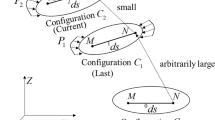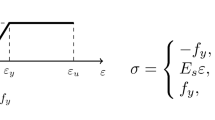Abstract
This paper presents a comprehensive approach for the design of planar structural steel members and framing systems using a direct computational buckling analysis configured with appropriate column, beam and beam-column inelastic stiffness reduction factors. The stiffness reduction factors are derived from the ANSI/AISC 360-16 Specification column, beam and beam-column strength provisions. The resulting procedure provides a rigorous check of all member in-plane and out-of-plane design resistances accounting for continuity effects across braced points as well as lateral and/or rotational restraint from other framing. The method allows for the consideration of any type and configuration of stability bracing. With this approach, no member effective length (K) or moment gradient and/or load height (C b ) factors are required. The buckling analysis rigorously captures the stability behavior commonly approximated by these factors. A pre-buckling analysis is conducted using the AISC Direct Analysis Method (the DM) to account for second-order effects on the in-plane internal forces. The buckling analysis is combined with cross-section strength checks based on the AISC Specification resistance equations to fully capture all the member strength limit states. This approach provides a particularly powerful mechanism for the design of frames utilizing general stepped and/or tapered I-section members.
Similar content being viewed by others
References
AASHTO (2015). AASHTO LRFD Bridge Design Specifications. 7th Edition with 2015 Interim Revisions, American Association of State Highway and Transportation Officials, Washington, DC.
AISC (2016). Specification for Structural Steel Buildings. ANSI/AISC 360-16, American Institute of Steel Construction, Chicago, IL.
AISC (2010). Specification for Structural Steel Buildings. ANSI/AISC 360-10, American Institute of Steel Construction, Chicago, IL.
AISC (2002). “Example Problems Illustrating the Use of the New Bracing Provisions-Section C3, Spec and Commentary”, Ad hoc Committee on Stability Bracing, November.
ASCE (1997). Effective Length and Notional Load Approaches for Assessing Frame Stability: Implications for American Steel Design. American Society of Civil Engineers, Reston, VA.
Cuk, P.E., Rogers, D.F. and Trahair, N.S. (1986). “Inelastic Buckling of Continuous Steel Beam-Columns.” Journal of Constructional Steel Research, 6(1), pp. 21–52.
Kirby, P.A. and Nethercot, D.A. (1979). Design for Structural Stability. Wiley, New York.
Kucukler, M., Gardner, L., Macorini, L. (2015a). “Lateral-Torsional Buckling Assessment of Steel Beams Through a Stiffness Reduction Method,” Journal of Constructional Steel Research, 109, pp. 87–100.
Kucukler, M., Gardner, L., and Macorini, L. (2015b). “Flexural-Torsional Buckling Assessment of Steel Beam-Columns Through a Stiffness Reduction Method.” Engineering Structures, 101, pp. 662–676.
Salvadori, M.G. (1955). “Lateral Buckling of Beams.” Transactions ASCE, Vol. 120, 1165.
Trahair, N.S. (2009). “Buckling analysis design of steel frames,” Journal of Constructional Steel Research, 65(7), pp. 1459–1463.
Trahair, N.S. (2010). “Steel cantilever strength by inelastic lateral buckling,” Journal of Constructional Steel Research, 66(8-9), pp. 993–999.
Trahair, N.S. and Hancock, G.J. (2004). “Steel Member Strength by Inelastic Lateral Buckling.” Journal of Structural Engineering, 130(1), pp. 64–69.
White, D.W., Jeong, W.Y. and Toğay, O. (2016). “SABRE2.” <white.ce.gatech.edu/sabre> (Sept 2, 2016).
Yura, J.A. (1971). “The Effective Length of Columns in Unbraced Frames,” Engineering Journal, AISC, April, pp. 37–42.
Yura, J.A., Galambos, T.V. and Ravindra, M.K. (1978). “The Bending Resistance of Steel Beams.” Journal of the Structural Division, ASCE, 104(ST9), pp. 1355–1370.
Ziemian, R. (2016). “MASTAN2 v3.5.” <www.mastan2.com> (Sept. 2, 2016).
Author information
Authors and Affiliations
Corresponding author
Rights and permissions
About this article
Cite this article
White, D.W., Jeong, W.Y. & Toğay, O. Comprehensive stability design of planar steel members and framing systems via inelastic buckling analysis. Int J Steel Struct 16, 1029–1042 (2016). https://doi.org/10.1007/s13296-016-0070-3
Received:
Accepted:
Published:
Issue Date:
DOI: https://doi.org/10.1007/s13296-016-0070-3




